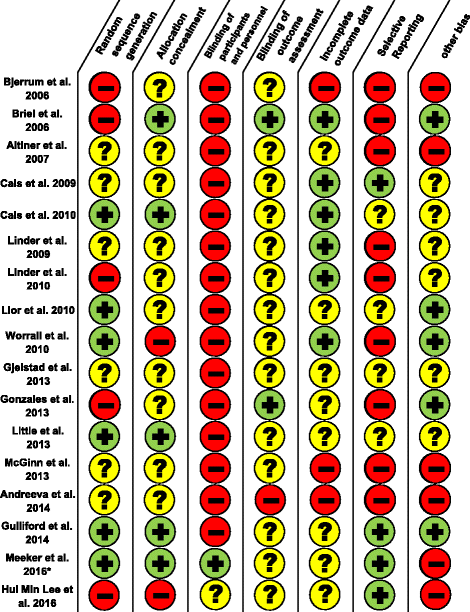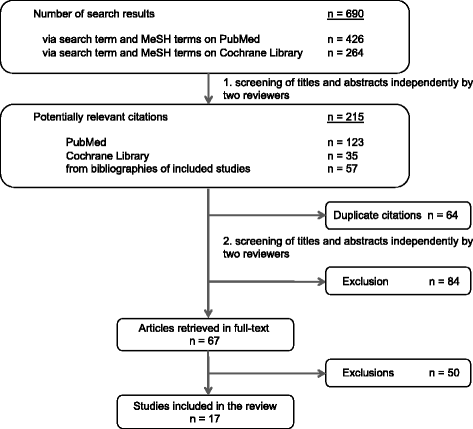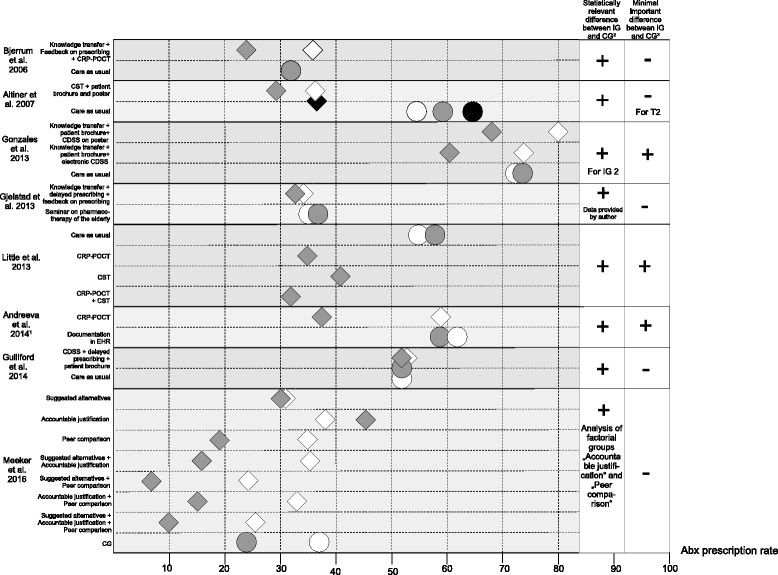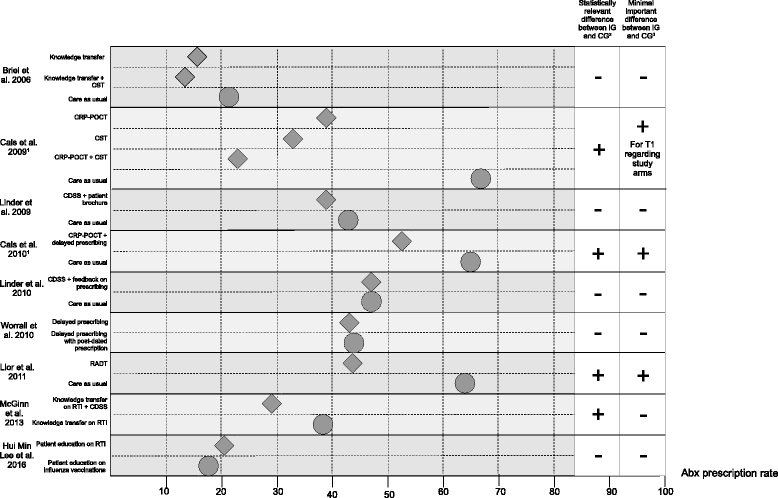Reduction of antibiotic prescriptions for acute respiratory tract infections in primary care: a systematic review
- PMID: 29554972
- PMCID: PMC5859410
- DOI: 10.1186/s13012-018-0732-y
Reduction of antibiotic prescriptions for acute respiratory tract infections in primary care: a systematic review
Abstract
Background: Although most respiratory tract infections (RTIs) are due to viral infections, they cause the majority of antibiotic (Abx) prescriptions in primary care. This systematic review summarises the evidence on the effectiveness of interventions in primary care aiming to reduce Abx prescriptions in patients ≥ 13 years for acute RTI.
Methods: We searched the databases "MEDLINE/PubMed" and "Cochrane Library" for the period from January 1, 2005, to August 31, 2016, for randomised controlled trials (RCTs) in primary care aiming at the reduction of Abx prescriptions for patients suffering from RTI. Out of 690 search results, 67 publications were retrieved and 17 RCTs were included. We assumed an absolute change of 10% as minimal important change.
Results: Twelve out of 17 included RCTs showed statistically significant lower Abx prescription rates in the intervention groups, but only six of them reported a clinically relevant reduction according to our definition. Communication skills training (CST) and point-of-care testing (POCT) were the most effective interventions. Pre-intervention Abx prescription rates varied between 13.5% and 80% and observed reductions ranged from 1.5 to 23.3%. Studies with post-intervention rates lower than 20% had no significant effects. Post-intervention observation periods ranged from 2 weeks up to 3.5 years. The design of the trials was heterogeneous precluding calculation of pooled effect size. The reporting of many RCTs was poor.
Conclusions: CST and POCT alone or as adjunct can reduce antibiotic prescriptions for RTI. Eleven out of 17 trials were not successfully reducing Abx prescription rates according to our definition of minimal important change. However, five of them reported a statistically significant reduction. Trials with initially lower prescription rates were less likely to be successful. Future trials should investigate sustainability of intervention effects for a longer time period. The generalisability of findings was limited due to heterogeneous designs and outcome measures. Therefore, a consensus of designing and reporting of studies aiming at reducing antibiotic prescriptions is urgently needed to generate meaningful evidence.
Keywords: Acute respiratory tract infections; Antibiotics; Primary care.
Conflict of interest statement
Ethics approval and consent to participate
Not applicable.
Consent for publication
Not applicable.
Competing interests
The authors declare that they have no competing interests.
Publisher’s Note
Springer Nature remains neutral with regard to jurisdictional claims in published maps and institutional affiliations.
Figures

 low risk of bias.
low risk of bias.  high risk of bias.
high risk of bias.  unclear risk of bias
unclear risk of bias

 . Circle = control group =
. Circle = control group =  . White = T0 = pre-intervention measurement/baseline. Grey = T1 = post-intervention measurement. Black = T2 = optional post-intervention measurement. 1 Results for subgroup of 13 physicians. 2 Evaluated by study team. 3 According to our definition: For studies with baseline and post-intervention measurements, a difference in differences of 10 percentage points within study arms is regarded as minimal important change
. White = T0 = pre-intervention measurement/baseline. Grey = T1 = post-intervention measurement. Black = T2 = optional post-intervention measurement. 1 Results for subgroup of 13 physicians. 2 Evaluated by study team. 3 According to our definition: For studies with baseline and post-intervention measurements, a difference in differences of 10 percentage points within study arms is regarded as minimal important change
 . Circle = control group =
. Circle = control group =  . Grey = T1 = post-intervention measurement. 1 Cals et al. 2009 and Cals et al. 2010: Antibiotic prescription data of the patient sample was captured during the index consultation (T1) and within 28 days after the index consultation (T2). Abx prescription rates for study arms are only available for T1. 2 Evaluated by study team. 3 According to our definition: For studies with post-intervention measurements, a difference of 10 percentage points between CG and IG is regarded as minimal important difference
. Grey = T1 = post-intervention measurement. 1 Cals et al. 2009 and Cals et al. 2010: Antibiotic prescription data of the patient sample was captured during the index consultation (T1) and within 28 days after the index consultation (T2). Abx prescription rates for study arms are only available for T1. 2 Evaluated by study team. 3 According to our definition: For studies with post-intervention measurements, a difference of 10 percentage points between CG and IG is regarded as minimal important differenceReferences
-
- Rautakorpi U-M, Huikko S, Honkanen P, wKlaukka T, Mäkelä M, Palva E, et al. The Antimicrobial Treatment Strategies (MIKSTRA) Program: a 5-year follow-up of infection-specific antibiotic use in primary health care and the effect of implementation of treatment guidelines. Clin Infect Dis 2006; 42:1221–1230. - PubMed
Publication types
MeSH terms
Substances
LinkOut - more resources
Full Text Sources
Other Literature Sources
Medical

